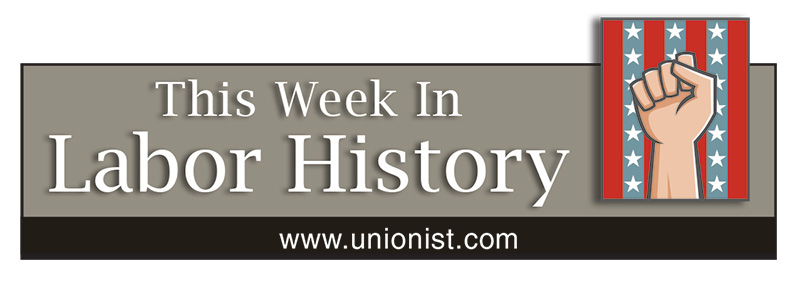This week in labor history: September 9-15

SEPTEMBER 9
1890 – In convention at Topeka, Kan., delegates create the Brotherhood of Railway Carmen of America. The men who repaired the nation’s rail cars were paid 10 or 15 cents an hour, working 12 hours a day, often seven days a week.
1919 – More than a thousand Boston police officers strike after 19 union leaders are fired for organizing activities. Massachusetts Gov. Calvin Coolidge announced that none of the strikers would be rehired, mobilized the state police, and recruited an entirely new police force from among unemployed veterans of the Great War (World War I).
1924 – Sixteen striking Filipino sugar workers on the Hawaiian island of Kauai are killed by police; four police died as well. Many of the surviving strikers were jailed, then deported.
1973 – United Auto Workers President Leonard Woodcock is named in Pres. Richard Nixon’s “Enemy’s List,” a White House compilation of Americans Nixon regarded as major political opponents. Another dozen union presidents were added later. The existence of the list was revealed during Senate Watergate Committee hearings.
SEPTEMBER 10
1897 – In Pennsylvania, Polish, Lithuanian and Slovak miners are gunned down by the Lattimer Mine’s sheriff deputies. Nineteen were killed and more than 50 wounded during a peaceful march from Hazelton to Lattimer. The miners, some 3,000 in total, were marching for collective bargaining and civil liberty. The shooters were tried for murder but the jury failed to convict.
SEPTEMBER 11
1897 – Some 75,000 coal miners in Pennsylvania, Ohio and West Virginia end a 10-week strike after winning an eight-hour day, semi-monthly pay, and the abolition of overpriced company-owned stores, where they had been forced to shop. (Remember the song, “Sixteen Tons,” by coal miner’s son Merle Travis, in which there’s this line: “I owe my soul to the company store.”)
2001 – More than 3,000 people died when suicide hijackers crashed planes into the World Trade Center towers, the Pentagon and a Pennsylvania field. Among the dead in New York were 634 union members, the majority of them New York City fire fighters and police on the scene when the towers fell.
2009 – Crystal Lee Sutton, the real-life Norma Rae of the movies, dies at age 68. She worked at a J.P. Stevens textile plant in Roanoke Rapids, N.C., when low pay and poor working conditions led her to become a union activist.
SEPTEMBER 12
1918 – Eugene V. Debs, Labor leader and socialist, sentenced to 10 years for opposing World War I. While in jail Debs received one million votes for president.
1934 – National Guardsmen fire on “sullen and rebellious” strikers at the Woonsocket (Rhode Island) Rayon plant, killing one and injuring three others. A correspondent said the crowd of about 2,000 “went completely wild with rage.” Word spread, 6,000 more workers arrived at the scene and the city was put under military rule. The governor declared that “there is a Communist uprising and not a textile strike” in the state.
1940 – A total of 49 people are killed, 200 injured, in explosion at the Hercules Powder Company plant in Kenvil, N.J.
1998 – New York City’s Union Square, the site of the first Labor Day in 1882, is officially named a national historic landmark. The square has long been a focal point for working class protest and political expression.
SEPTEMBER 13
1926 – The Post Office Department orders 25,000 railway mail clerks to shoot to kill any bandits attempting to rob the mail.
1971 – Eleven AFSCME-represented prison employees and 33 inmates die in four days of rioting at New York State’s Attica Prison and the retaking of the prison. The riot caused the nation to take a closer look at prison conditions, for inmates and their guards alike.
SEPTEMBER 14
1901 – The Amalgamated Association of Iron, Steel, and Tin Workers union calls off an unsuccessful three-month strike against U. S. Steel Corporation subsidiaries.
1929 – Gastonia, N.C., textile mill striker and songwriter Ella Mae Wiggins, 29, a mother of five, is killed when local vigilantes and thugs force the pickup truck in which she is riding off the road and begin shooting.
1933 – A striker is shot by a bog owner (and town-elected official) during a walkout by some 1,500 cranberry pickers, members of the newly-formed Cape Cod Cranberry Pickers Union Local 1. State police were called, more strikers were shot and 64 were arrested. The strike was lost.
1959 – Congress passes the Landrum-Griffin Act. The law expands many of the anti-labor provisions of the Taft-Hartley Act, increasing union reporting requirements and restricting secondary boycotting and picketing.
SEPTEMBER 15
1845 – Some 5,000 female cotton workers in and around Pittsburgh, Pa. strike for a 10-hour day. The next day, male trade unionists become the first male auxiliary when they gather to protect the women from police attacks. The strike ultimately failed.
1970 – More than 350,000 members of the United Auto Workers begin what is to become a 69-day strike against General Motors.
(Labor History is provided by Union Communications Services, since 1981 North America’s premier publisher and distributor of newsletters, leadership training programs for shop stewards and officers, website materials and other powerful use-it-today strategies and tools to help leaders and activists build union power. Reach them at unionist.com.)


Leave a Reply